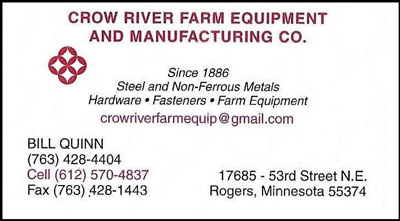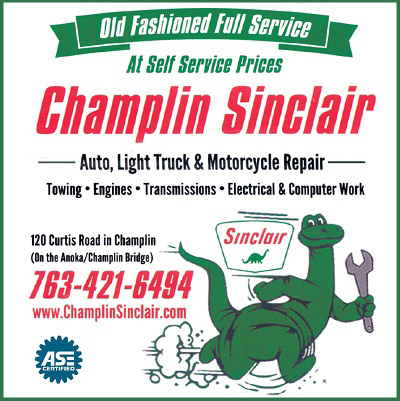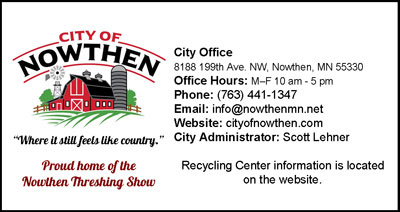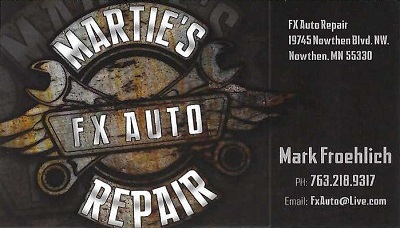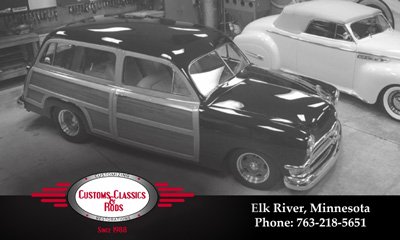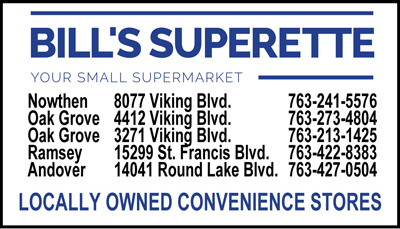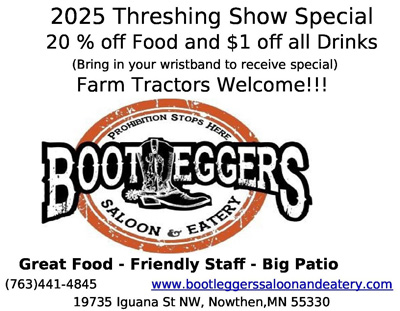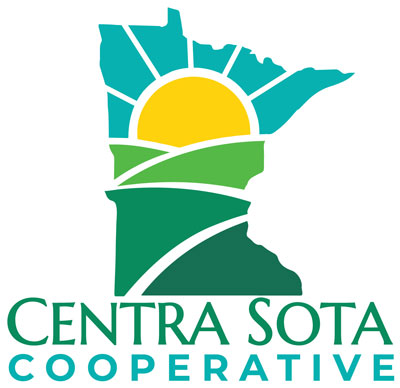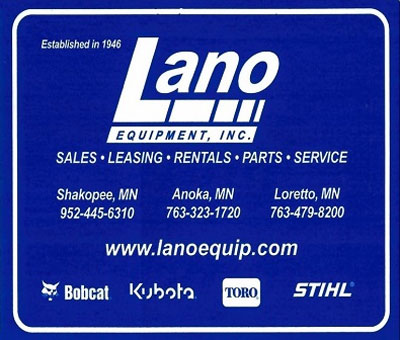The Nowthen Threshing Show Features Ford and Fordson
August 17 - 19, 2012
This year along with the long history of Ford and Fordson tractors, NHPA is also happy to feature Ford cars and trucks. Click here to read the additional feature article on the versatile Ford Model T.
History of the Ford Tractors
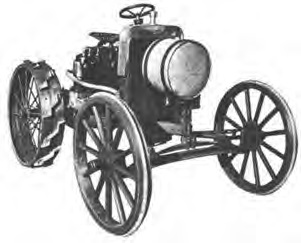 The first experimental tractor produced by Henry Ford and his company, featured in the Henry Ford museum. This tractor was completed in 1907 under the direction of chief engineer Joseph Galamb. It’s interesting to note that the name “tractor” was never applied to this machine, as the term was not widely used at this time. It was instead referred to as an “automobile plow,” and, in fact, used many parts from the Ford line of cars in order to cut development and production costs. It would be nearly a decade later before production would start on the first viable commercial model, the Fordson Model F.
The first experimental tractor produced by Henry Ford and his company, featured in the Henry Ford museum. This tractor was completed in 1907 under the direction of chief engineer Joseph Galamb. It’s interesting to note that the name “tractor” was never applied to this machine, as the term was not widely used at this time. It was instead referred to as an “automobile plow,” and, in fact, used many parts from the Ford line of cars in order to cut development and production costs. It would be nearly a decade later before production would start on the first viable commercial model, the Fordson Model F.
The Ford Motor Company was founded in June, 1903. After a rocky start, the company achieved tremendous success with the launch of the famous Model T in 1908. From this year until 1927, the company would sell more than 15 million Model T cars and trucks.
While Ford achieved great success in the consumer automobile market, he was the son of a farmer himself and understood the need and usefulness of applying automotive technology to the process of farming. His strong support for the tractor is evident by his experimental work beginning in 1907, but his efforts to start production were delayed by a board of directors that was well satisfied with the sales and profits from the Model T cars and weary of taking a chance on what was an un-established industry.
Despite the opposition to his plans, Ford continued development work on his tractor. He employed Eugene Farkas as his chief engineer on the project, replacing Joseph Galamb in that position, who had developed many of the earliest tractor prototypes. As development work proceeded, and it became clear that the Ford Motor Company and its directors were completely unwilling to produce a tractor, Henry Ford set up an independent company to build and market the machine. In 1917, the Henry Ford & Son Corporation was set up for this purpose, with Henry Ford firmly in control.
The tractor was given a substantial boost by the outbreak of the First World War in 1914. Food was desperately needed to feed the massive armies that were doing battle, but enormous manpower that would ordinarily be employed in farming was called away to battle. Farm tractors were the answer to the problem, which offered power and efficiency that would allow for greater production of food with fewer farmers. Ford had not invented the tractor, just as he had not invented the car, but as he had done with the automobile, he designed and produced a tractor that was affordable to the masses and revolutionized the industry. The days of plows pulled by horses were numbered. The Henry Ford & Son Company would build the machine that would change the world of farming forever.
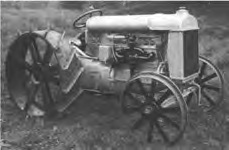
Fordson Model F
20 H.P., four cylinder engine
delivered 10 H.P. on the drawbar
3 speed spur gear transmission
Produced from 1917-1928 at Dearborn in America
Produced from 1919-1922 at Cork, Ireland
The Fordson Model F was rolled out in 1917 in limited production, and scaled up to mass production in 1918 to meet the urgent need for tractors by the British government. Owing to the ongoing dispute with the board of the Ford Motor Company, Henry Ford chose to market the farm tractors with the Fordson name, a shortened form of the Henry Ford & Son Company that was actually producing the tractor at this time. When Ford assumed sole control of Ford in 1920, the Henry Ford & Son Company was rolled into the Ford Motor Company, but the Fordson name was kept.
The Fordson was revolutionary first and foremost because it was a smaller design than many of the tractors produced by other companies at the time. These other companies were operating under the mistaken belief that bigger is better. The smaller design of the Fordson allowed the tractor to be affordable and easy to produce. Especially important to that goal, the new Ford tractors lacked a conventional frame. Instead, the engine, transmission, and axle housings were all bolted together to form the basic structure of the tractor. With the small size and innovative frame of the first Fordson, the tractor was well-suited for the mass production Ford had brought to the Model T. As a result of this, the machine could be sold at a much lower price affordable to average farmers. Just as Ford had brought the car to the middle class through assembly line production, the tractor was now also within reach.
Towards the second half of the 1920’s, the agricultural market entered a depression because of the declining farm prices, years before the rest of the country would follow. Because of declining market fortunes, the decision was made to suspend production of farm tractors in early 1928. This move was partially reversed when strong demand for tractors by the Soviet Union and an urgent need for spare parts prompted Ford to reopen the Cork, Ireland, production facility. But the engineers now designed a new model that was to be built at this factory, the Model N. The main change involved the increase in horsepower for the engine, which was achieved by increasing the cylinder bore by 1/8 of an inch. All production of Ford tractors was now centered in Europe.
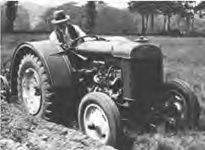
Fordson Model N
27.3 H.P., four cylinder engine
delivered 13.6 H.P. on the drawbar
Featured pressurized water pump
All other specifications similar to Fordson F
Produced from 1929-1932 at Cork, Ireland, until transferred to Dagenham, England
Produced from 1933-1945 at Dagenham, England
It was during this period, from 1928-1939, that Ford lost their dominance of the American tractor market. Owing to the higher cost of importing Ford farm tractors from Ireland, and then Britain, and to the development of newer models by American competitors that made the Fordson look obsolete, Ford’s market share slipped, eventually to a low of five percent. An attempt to improve their American position with the launch of the Fordson All-Around, a row-crop version of the N with a 3-wheel style arrangement was modestly successful in the British market, but met with almost no success in America, where it was marketed as the Fordson Row Crop.
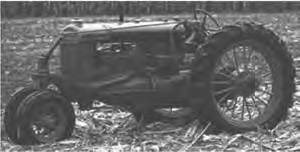
Fordson All-Around (a.k.a. Fordson Row Crop in U.S.)
Modest revision of the Fordson N with tricycle style wheel arrangement
Produced beginning in 1937 at Dagenham
The situation was unacceptable to Henry Ford, who decided to retake the tractor industry for the Ford Motor Company. Towards the second part of the 1930’s, he commissioned development work on a new model tractor that could replace the Fordson and which could be produced in bulk for the American market. Early prototypes looked good, but just as development was underway Harry Ferguson came to visit Henry Ford and brought with him a Ferguson-Brown tractor, which he was producing in England with David Brown. The performance of the tractor impressed Ford and the two came to an agreement, a handshake agreement, by which Ford would produce tractors using Ferguson’s patents and Ferguson, in turn, would market these machines. Ford engineers, using the Ferguson-Brown tractor as their model, and with the assistance of Harry Ferguson, developed the Ford 9N. The Fordson name and models would be sold in Europe, but the Ford N-series would grow to dominance in America.
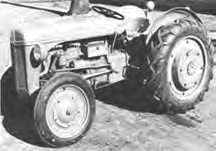
Ford 9N (a.k.a. Ford-Ferguson 9N)
28 H.P., 119.7 cubic inch displacement, 4 cylinder engine
featured standard rubber tires, electrical system w/starter, battery, generator, power takeoff, large capacity cartridgetype
oil filter, and oil bath air cleaner
used direct-driven distributor with integral coil as opposed to magneto ignition
3-speed transmission
Produced from 1939-1943 at Dearborn, Michigan (until replaced by 2N due to war shortages)
The 9N was very successful and represented a true revolution in design when compared to the Fordson. The use of the Ferguson System for implement attachment and control was a great improvement over the straight drawbar of the old Fordsons. The three point hitch allowed for the easy attachment and removal of implements and the system of draft control allowed for the regulation of the working depth of the implement, which helped especially on steep slopes. It was also a good deal quieter and safer than the Fordsons, which added to its popularity. Combined with the benefits of mass production, the new Ford farm tractors were able to be sold at a price much lower than those of competitors, which put Ford back on top of the sales charts.
The 9N would have been an even greater success in terms of sales were it not for the outbreak of the Second World War and American participation in 1941, a development which made raw materials for production of the Ford farm tractors difficult to acquire. Because of this, in 1942, Ford was forced to cease production of the 9N in favor of the 2N, a revised version of the tractor designed to use materials that were not as scarce. The 2N was basically the same as the 9N in terms of specifications, but featured steel wheels and replaced the generator and battery with a magneto.
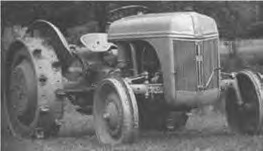
Ford 2N (a.k.a. Ford-Ferguson 2N)
Featured steel wheels
Generator and battery of 9N replaced by magneto
All other specifications similar to Ford 9N
Produced from 1942-1947 at Dearborn, Michigan
Meanwhile, in England, the Fordson still reigned as king of the tractor landscape, and much to the annoyance of Harry Ferguson, no plans were made to introduce farm tractors based on his system or the N-series in that country. The Second World War delayed all efforts at producing a new model, but work was done on designing a model to be produced after the war was over. And this new model would be a Fordson, based on the same basic design as the original 1917 tractor that had launched Ford into the tractor industry. Whereas the Ford 9N represented a major departure, the development of the new tractor for the English market would be a minor evolution. This development resulted in the E27N Fordson Major, a tractor which continued the Ford hold on the British market. The main differences in the new model were the availability of a diesel version, a sturdier structure, and the elimination of the inefficient worm wheel final drive. Land Utility, Row-Crop, Industrial, and Standard Agricultural versions of the new Fordson were available.
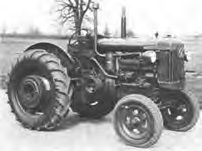
E27N Fordson Major
28.5 H.P., 1100 rpm 4 cylinder mixed fuel engine
delivered 19 H.P. at the drawbar
45 H.P. Perkins P6 diesel engine also available
Pulley and power takeoff optional
Available in Land Utility, Row-Crop, Industrial, and Standard Agricultural versions
Produced from 1945-1951 at Dagenham, England
Meanwhile, back in the States, Edsel, Ford’s son, died in 1943, prompting Henry Ford to come back as President of Ford. But in his advanced age he was unable to effectively run the company, and soon stepped aside in favor of his grandson, Henry Ford II, in September 1945. Henry Ford would die in April 1947, at the age of 83. The man who had brought the automobile into the homes of average Americans and who had pioneered the assembly line and the instruments of mass production had passed.
And with his death, the handshake agreement between Ford and Ferguson soon collapsed. Henry Ford II disliked the lack of marketing control over the tractor business (since all marketing and distribution was handled by Ferguson in the original agreement) and soon announced that Ford would be establishing their own distribution and marketing company to distribute an improved version of the 9N. The decision to cut Ferguson out would be a very costly one, as he was now in a position to directly compete with Ford. But that would be a few years off, and Ford would be on top with the 8N, the improved version of the 9N/2N, and their best selling tractor ever.
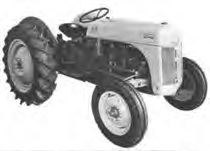
Ford 8N
30 H.P., 4 cylinder engine
4-speed transmission
Position Control in addition to automatic depth control
Improved brake system with both pedals on right side
Improved steering
New Hydraulic Touch Control
Changes in hydraulic control system to attempt to avoid violating active Ferguson patents
Produced from 1947-1952 at Dearborn, Michigan
The Ford 8N represented a refinement of the 9N / 2N line. One of the most important developments in the new line was the four speed transmission that made the tractor a good deal more productive and flexible. The Position Control system was also useful in that it allowed implements to remain at the same height relative to the tractor, as opposed to the automatic depth control on the original Ferguson system that had allowed the depth to vary. The Ford 8N still basically used the same Ferguson System that had been incorporated in the 9N / 2N line, and this unauthorized use of the Ferguson patents was one of the main contentions in the Ferguson lawsuit. The lawsuit, filed by Harry Ferguson after the termination of the handshake agreement, claimed damages for loss of sales because of the ending of the marketing agreement and because of the infringement of his patents, and went on to be one of the most lengthy and costly suits of its kind. The Ford 8N would have had a longer and still more successful run were it not for fierce competition from the Ferguson TO-30, and the lawsuit, which eventually forced Ford to have to use a new hydraulic control system and make other changes to avoid using patents that were held by Ferguson. These changes were incorporated in the new Ford NAA, often called the Jubilee. This Golden Jubilee logo was used to celebrate the 50th anniversary of the founding of Ford at the time of the NAA launch in 1953.
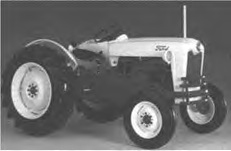
Ford NAA (a.k.a. Golden Jubilee)
31 H.P. 134 cubic inch, overhead valve 4 cylinder engine
Changes to hydraulic control to conform to settlement of Ferguson lawsuit
Optional live PTO
All other specifications similar to Ford 8N
Produced from 1953-1954 at Dearborn
Meanwhile, the E27N was beginning to show its age back in England, at a time when Ferguson was on the rise with his TE line of tractors. The total dominance that Ford had once enjoyed in the British market could no longer be assumed as a given. To combat declining sales, Dagenham developed a new revolutionary engine to be introduced in the successor to the Fordson Major. The engine would be available in a diesel version, which had proven itself as a popular option on the Major. Combined with many other minor improvements on the continuing Fordson basic design, the Fordson New Major was released in 1952. With the release, Ford put the British market in the lead in the use of diesel power. Diesel was popular in Europe because of the greater fuel efficiency of diesel engines, which was an important feature in a market with high fuel prices.
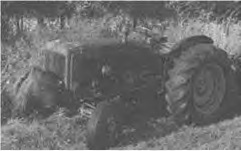
Fordson New Major
Featured a revolutionary new engine in gasoline-kerosene, gasoline, and diesel versions
Diesel version most popular of the various engine types
Compression ranged from 4:1 kerosene to 16:1 diesel for same basic block
Produced from 1952-1958 at Dagenham
Henry Ford had a deeply held belief that one automobile, if made right, would be good enough for just about everyone. While this made mass production much easier and helped reduce costs, the Ford Motor Company would learn the hard way that one size does not fit all. The Model T was a great machine for its time, but could not be all things to all people. This is why the Ford car division broke with Ford’s philosophy of one basic model and matched their competitors with a wide range of models targeted at a wide range of markets. But up until this time the old Ford philosophy had survived in the tractor division. In America, Ford sold one model of tractor targeted at the “average” farmer. In England, Ford sold one model of tractor. New models were introduced, but Ford offered only one model for sale at any particular time.
This practice of a simplified product line came to an end with the NAA in 1954. In that year Ford stopped production of their last one model tractor. The 600 and 800 series of tractors were launched. The 600 series tractors were based on the NAA design and aimed at the small farm equipment market, whereas the 800 series was more powerful and focused at larger farming applications.
The 600 series featured the same 134 cubic inch engine as the NAA had. The 640 was essentially the same tractor as the NAA, the 650 featured a new five speed transmission, and the 660 had a five speed transmission and a live PTO, a feature which had been optional on the Jubilee. The 800 series featured an improved 172 cubic inch version of the NAA engine, and came standard with the new five speed transmission. The 850 had the dependent PTO, as opposed to the live PTO of the 860.
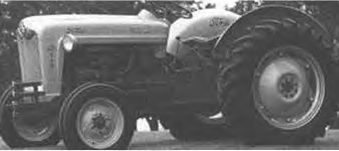
Ford 600 Series
Featured same engine as Ford NAA
640 nearly identical to NAA
650 featured five speed transmission
660 featured five speed transmission, live PTO (power takeoff)
Ford 800 Series
Featured an improved, 172 cubic inch engine
New five speed transmission as standard
850 had dependent PTO
860 featured newer, live PTO
Produced from 1954-1957 at Dearborn
Ford was now interested in pursuing all the various tractor markets with their redesigned lines, and this meant having tricycle-style tractors. If their competitors offered something, they would match it. Still working with the NAA as their basic design, Ford launched the 700 and 900 series to parallel the 600 and 800 in features, but with a three wheel design.
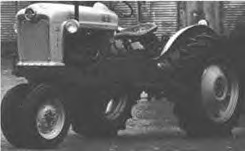
Ford 700 / 900 Series
Features and configurations parallel to 600 / 800 Series
Featured a three wheel tricycle design
Produced from 1954-1957 at Dearborn
1957 was the year that Ford decided to spruce up the appearance and identification of their product line. The biggest change was the addition of a cross section of bars across the front grille. All existing models were kept the same in terms of specifications, but the 1 suffix was added in place of the 0 at the end of each model. Also, the differences between the engine size of the 600 and 800 Series, now the 601 and 801 Series, was augmented by the addition of Workmaster, designating the smaller 134 cubic inch engine, and Powermaster, which was used for the larger 172 cubic inch design. Liquid petroleum gas was now also an option on all Ford tractors.
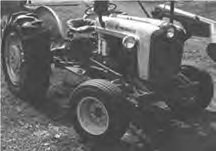
Ford 601 / 701 / 801 / 901 Series
Features and configurations similar to 600 / 700 / 800 / 900 Series
Minor changes to appearance, new grille look
Produced from 1957-1962 at Dearborn
As development in America was marching forward with the 600-900 series and the revived 601-901 line, England was moving ahead with revisions of their own. The Fordson New Major had been very successful, but that tractor was rather large, and the lack of a small tractor for those with lesser needs was hurting Ford’s position in Europe. To address this weakness in the product line, Ford developed the Dexta in 1957, which featured a Perkins three cylinder diesel engine.
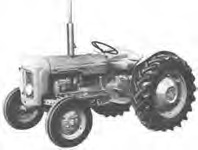
Fordson Dexta
Featured three cylinder Perkins diesel engine
Targeted at the small farm equipment market
Produced from 1957-1961 at Dagenham
The next year, the New Major was replaced with the Power Major. The Power Major, as the name difference may suggest, featured a more powerful version of the engine that had revolutionized the tractor industry in Europe by introducing diesel at a competitive price.
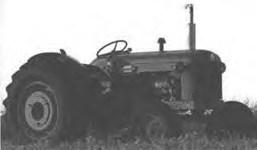
Fordson Power Major
Featured a more powerful engine
Diesel, gas, and distillate versions available
Produced from 1958-1961 at Dagenham
Ford would roll out upgraded versions of each of these tractors. The Super Major replaced the Power Major in 1961, and the Super Dexta replaced the Dexta in 1962. These two models would be the last of the Dagenham designs, as production was shifted from there to nearby Basildon for U.K. production in 1964. They would also be the last separate British designs, as soon the Tractor Division would become unified.
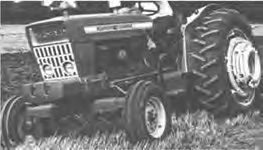
Fordson Super Major (a.k.a. Ford 5000 in America)
Improved version of the Power Major
Produced from 1961-1964 at Dagenham
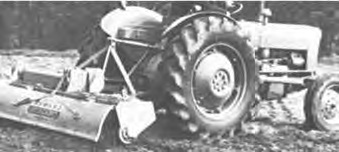
Fordson Super Dexta (a.k.a. Ford 2000 Diesel in America)
Improved version of the Dexta
Produced from 1962-1964 at Dagenham
In 1959, Ford introduced the Select-O-Speed transmission system. It was supposed to provide a system with ten forward speeds, two in reverse. The system was designed to allow farmers greater control for use of machinery over rough terrain. The project became something of a disaster at first, however, and needed much repair and redesign on the earliest models. The project dragged out, and after a long period of redevelopment, later models of Select-O-Speed were successful.
In late 1961, Ford introduced the 2000 series to replace the 601, the 4000 line to replace the 801 series, and the 6000 as the top of the line, with a powerful six cylinder engine. The Ford 6000 was a failure, however, and Ford was forced to replace all of them due to technical problems. Making moves towards unification, the Fordson Super Dexta was imported and sold in America as the Ford 2000 Diesel, and the Fordson Super Major was imported as the Ford 5000. In 1964, a plant was opened at Antwerp, in Belgium, to provide for European tractor production. The world tractor line that Henry Ford had always favored was now a reality, with the same single set of tractors sold across the world. No longer would the Ford Tractor Division be separated into Ford and Fordson.
In 1965, the entire range from the 2000 to the 4000 was revamped, with a new three cylinder diesel engine. The 5000 was equipped with a four cylinder diesel, and the 6000 was renamed the Commander 6000 and was redesigned to fix the earlier technical problems with the same specifications. This line would continue, receiving expansions until it ranged from 2000 to 9000, until 1975.
The Ford Motor Company was one of the largest and most successful companies in the tractor industry. Ford was one of the early leaders in mass production and the assembly line, and they took these strengths with them in their production of tractors. This allowed them to offer these machines, in the early days, at prices no one could touch, and this made Ford one of the keys towards the mechanization of agriculture. It is a testament to the quality and durability of the machines they produced that many of them are still running and being actively used throughout the world, five decades or more past their production dates. Their beauty is recognized by those that collect and restore these symbols of American pride and progress. Though the Ford Motor Company may have sold their tractor division to Fiat Agri in 1993, their legacy and heritage live on throughout the American heartland.
Provided by www.ford-fordson.org









